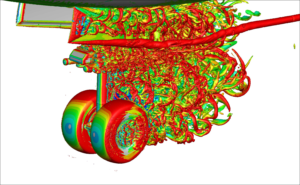Date: Jul 22, 2021
Candidate: Tulio Rodarte Ricciardi
Advisor:
Prof. Dr. William Roberto Wolf, Instituto de Computação
Abstract:
Noise predictions of landing gear configurations are obtained combining high-fidelity CFD simulations and the Ffowcs Williams and Hawkings (FWH) acoustic analogy. Different geometries are investigated, including the scale-model LAGOON and a full-scale realistic landing gear. The aeroacoustic prediction of such a complex aeronautical system depends on the ability of the mesh and numerical methods to resolve important flow features. In this sense, both geometries are first studied with a baseline grid. With the knowledge acquired from this initial assessment, a second grid with finer discretization is designed to improve numerical accuracy. Hence, better solutions of the fluctuation fields and noise generation mechanisms are achieved. Results are presented in terms of time-averaged and unsteady hydrodynamic data and noise predictions, the latter computed using the Ffowcs Williams and Hawkings formulation. The LAGOON landing gear is investigated for two reasons. First, it presents an extensive experimental and numerical database available in the literature and it is an important milestone for validation of the numerical tools and methodology employed in this work. Second, despite being a model landing gear, this configuration presents a rich flow physics with the same trends observed in more complex geometries. Hence, the knowledge from this case can be applied to the second, more complex, configuration. For the realistic landing gear, two setups with different levels of fidelity are analyzed. One is a simplified setup, where small components are removed, and the other is a full complexity setup including all geometrical features. With results from both cases, it is possible to investigate the role of small scale components on the flow dynamics and noise generation. It is important to understand if the simplified configuration can capture all the relevant physics compared to the full complexity one, but at a reduced computational cost. The identification and analysis of noise sources is performed by applying acoustic analogies to individual components of the landing gear to identify potential sources of tonal noise. Then, proper orthogonal decomposition is applied to identify mechanisms of noise generation at specific frequencies. It is shown that turbulent coherent structures are responsible for tonal noise generation by different components, including the towing link, wheel cavities and landing gear compartment. For the external cavity of the wheel, a Rossiter mode is excited and leads to resonance. Improving the capability to perform numerical noise predictions and source identification of complex configurations should provide the means to design aircraft with reduced noise emissions.


